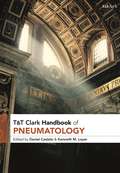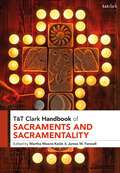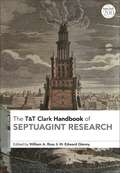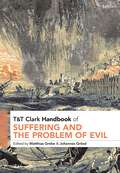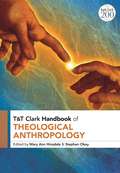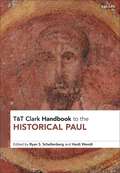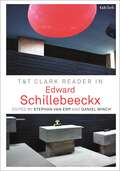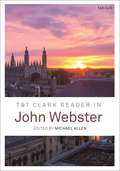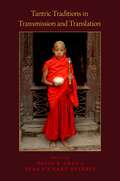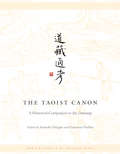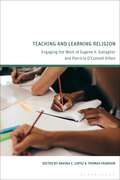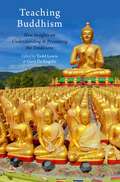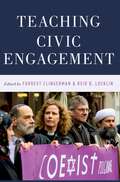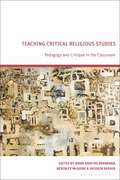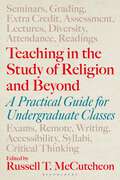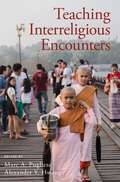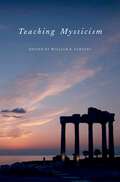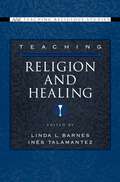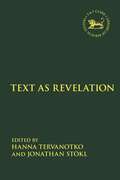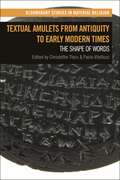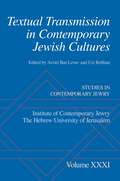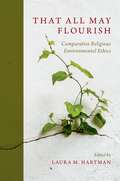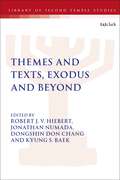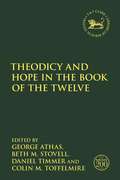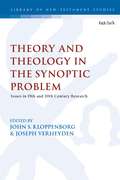- Table View
- List View
T&T Clark Handbook of Pneumatology (T&T Clark Handbooks)
This handbook provides an interdisciplinary and diverse reference work to the Holy Spirit. Daniel Castelo and Kenneth M. Loyer gathered together a wide range of voices that are religiously, geographically, and ethnically diverse, bringing theology into conversation with biblical studies, ethics and morality, and global Christian studies.The T&T Clark Handbook of Pneumatology examines the Holy Spirit in a variety of sources, such as the Synoptic Gospels, the Catholic Epistles, the Old Testament, and the Hebrew Scriptures. It also includes chapters on key concepts in the field, such as mediation and sacramentality, ecology, and creation. This broad scope enables readers to appreciate how nuanced the field of Pneumatology is, and how it can be relevant for other Christian discourses.
T&T Clark Handbook of Sacraments and Sacramentality (T&T Clark Handbooks)
Introducing readers to the contemporary field of sacramental theology, this volume covers the biblical and historical foundations, a survey of the state of the discipline, and a collection of constructive essays representing major themes, practices and approaches to sacraments and sacramentality in the contemporary world.The volume starts with a set of foundational essays that offer broad introduction to the field of sacramental theology from contemporary scholars, analysing a number of historical figures in order to illumine and inform contemporary sacramental theology. The second part of the volume is dedicated to a series of essays on sacramentality, and includes attention to elements of space, time, ritual action, music, and word, all as aspects of what Christians have termed “sacramental” reality. The third set of essays includes attention to each of the seven practices that have most commonly been termed “sacraments” in Christian traditions: baptism; eucharist/Lord's Supper; confirmation; confession, forgiveness and reconciliation; marriage; ordination; and anointing. The final part of this volume features scholars who are working on sacraments in conversation with contemporary academic disciplines: critical race theory, queer theory, comparative theology, and disability studies.
T&T Clark Handbook of Septuagint Research (T&T Clark Handbooks)
Students and scholars now widely recognize the importance of the Septuagint to the history of the Greek language, the textual development of the Bible, and to Jewish and Christian religious life in both the ancient and modern worlds. This handbook is designed for those who wish to engage the Septuagint in their research, yet have been unsure where to turn for guidance or concise, up-to-date discussion. The contributors break down the barriers involved in the technical debates and sub-specialties as far as possible, equipping readers with the tools and knowledge necessary to conduct their own research. Each chapter is written by a leading Septuagint scholar and focuses upon a major area of research in the discipline, providing an overview of the topic, key debates and views, a survey or demonstration of the methods involved, and pointers towards ongoing research questions. By exploring origins, language, text, reception, theology, translation, and commentary, with a final summary of the literature, this handbook encourages active engagement with the most important issues in the field and provides an essential resource for specialists and non-specialists alike.
T&T Clark Handbook of Suffering and the Problem of Evil (T&T Clark Handbooks)
The T&T Clark Handbook of Suffering and the Problem of Evil provides an extensive exploration of the theology of theodicy, asking questions such as should all instances of suffering necessarily be understood as evil? Why would an omnipotent and benevolent God allow or perpetrate evil? Is God unable or unwilling to reduce human and non-human suffering on Earth? Does humanity have the capacity to exercise a moral evaluation of God's motives and intentions? Conventional disciplinary boundaries have tended to separate theological approaches to these questions from philosophical ones. This volume aims to overcome these boundaries by including biblical (Part I), historical (Part II), doctrinal (Part III), philosophical (Part IV), and pastoral, interreligious perspectives and alternative intersections (Part V) on theodicy.Authors include thinkers from analytic and continental traditions, multiple Christian denominations and other religions, and both established and younger scholars, providing a full variety of approaches. What unites the essays is an attempt to answer these questions from the perspective of biblical testimony, historical scholarship, modern theological and philosophical thinking about the concept of God, non-Christian religions, science and the arts. The result is a combination of in-depth analysis and breadth of scope, making this a benchmark work for further studies in the theology of suffering and evil.
T&T Clark Handbook of Theological Anthropology (T&T Clark Handbooks)
Including classical, modern, and postmodern approaches to theological anthropology, this volume covers the entire spectrum of thought on the doctrines of creation, the human person as imago Dei, sin, and grace. The editors have gathered an exceptionally diverse range of voices, ensuring ecumenical balance (Protestant, Roman Catholic and Orthodox) and the inclusion of previously neglected perspectives (women, African American, Asian, Latinx, and LGBTQ). The contributors revisit authors from the “Great Tradition” (early church, medieval, and modern), and discuss them alongside critical and liberationist approaches (ranging from feminist, decolonial, and intersectional theory to critical race theory and queer performance theory). This is a much-needed overview of a rapidly evolving field.
T&T Clark Handbook to the Historical Paul (T&T Clark Handbooks)
The T&T Clark Handbook to the Historical Paul gathers leading voices on various aspects of Paul's biography into a thorough reconsideration of him as a historical figure. The contributors show how recent trends in Pauline scholarship have invited new questions about a variety of topics, including his social location, his mode of subsistence, his cultural formation, his place within Judaism, his religious experience and practice, and his affinities with other religious actors of the Roman world. Through careful attention to biographical detail, social context, and historical method, it seeks to describe him as a contextually plausible social actor.The volume is structured in three parts. Part One introduces sources, methods, and historiographical approaches, surveying the foundational texts for Paul and the early Pauline tradition. Part Two examines key biographical questions pertaining to Paul's bodily comportment, the material aspects of his career, and his religious activities. Part Three reconstructs the biographical portraits of Paul that emerge from the letters associated with him, presenting a series of “micro-biographies” pieced together by leading Pauline scholars.
T&T Clark Reader in Edward Schillebeeckx
This reader shows why Edward Schillebeeckx remains one of the most influential Catholic theologians of the 20th century. Spanning more than half a century and including several texts that appear in English for the first time, it enables students to understand how Edward Schillebeeckx's thought resonates with current debates in theology, for instance on ecology and secularization.T&T Clark Reader in Edward Schillebeeckx includes selections from both pre- and post-Conciliar texts that illustrate the evolution in Schillebeeckx's thought, while also pointing towards the deep underlying continuity which comes from his essential commitment to his faith. His Christological Trilogy, which was a touchstone for doctrinal controversy and methodological progress, is represented here, as well as important works on ministry, the sacraments, hermeneutics, secularization, and the environment. These complex theological topics are broken down in every chapter with the help of explanatory notes, discussion questions and further reading suggestions. This reader is an essential resource which will enable students to contextualize and unpack the rich layers within Schillebeeckx's theology.
T&T Clark Reader in John Webster
This Reader charts John Webster's theology from its earliest development, guiding the reader through selective essays that represent his corpus. It is an excellent introduction to the breadth of his writings, which teaches students how to engage with his particular mode of theological argument.T&T Clark Reader in John Webster starts with a biographical, chronological and topical survey of Webster's theological development. It notes his shifting conversation partners and his abiding theological principles. The editor places the essays in context with short introductions, as well as editorial footnotes clarifying key terms, historical or exegetical arguments or polemical emphases. This is an essential introduction to Webster's work and his impact on classical and contemporary theology.
Tantric Traditions in Transmission and Translation
Tantric traditions in both Buddhism and Hinduism are thriving throughout Asia and in Asian diasporic communities around the world, yet they have been largely ignored by Western scholars until now. This collection of original essays fills this gap by examining the ways in which Tantric Buddhist traditions have changed over time and distance as they have spread across cultural boundaries in Asia. The book is divided into three sections dedicated to South Asia, Central Asia, and East Asia. The essays cover such topics as the changing ideal of masculinity in Buddhist literature, the controversy triggered by the transmission of the Indian Buddhist deity Heruka to Tibet in the 10th century, and the evolution of a Chinese Buddhist Tantric tradition in the form of the True Buddha School. The book as a whole addresses complex and contested categories in the field of religious studies, including the concept of syncretism and the various ways that the change and transformation of religious traditions can be described and articulated. The authors, leading scholars in Tantric studies, draw on a wide array of methodologies from the fields of history, anthropology, art history, and sociology. Tantric Traditions in Transmission and Translation is groundbreaking in its attempt to look past religious, linguistic, and cultural boundaries.
The Taoist Canon: A Historical Companion to the Daozang
Taoism remains the only major religion whose canonical texts have not been systematically arranged and made available for study. This long-awaited work, a milestone in Chinese studies, catalogs and describes all existing texts within the Taoist canon. The result will not only make the entire range of existing Taoist texts accessible to scholars of religion, it will open up a crucial resource in the study of the history of China. The vast literature of the Taoist canon, or Daozang, survives in a Ming Dynasty edition of some fifteen hundred different texts. Compiled under imperial auspices and completed in 1445—with a supplement added in 1607—many of the books in the Daozang concern the history, organization, and liturgy of China's indigenous religion. A large number of works deal with medicine, alchemy, and divination. If scholars have long neglected this unique storehouse of China's religious traditions, it is largely because it was so difficult to find one's way within it. Not only was the rationale of its medieval classification system inoperable for the many new texts that later entered the Daozang, but the system itself was no longer understood by the Ming editors; hence the haphazard arrangement of the canon as it has come down to us. This new work sets out the contents of the Daozang chronologically, allowing the reader to follow the long evolution of Taoist literature. Lavishly illustrated, the first volume ranges from antiquity through the Middle Ages, while the second spans the modern period. Within this frame, texts are grouped by theme and subject. Each one is the subject of a historical abstract that identifies the text's contents, date of origin, and author. Throughout the first two volumes, introductions outline the evolution of Taoism and its spiritual heritage. A third volume offering biographical sketches of frequently mentioned Taoists, multiple indexes, and an extensive bibliography provides critical tools for navigating this guide to one of the fundamental aspects of Chinese culture.
Teaching and Learning Religion: Engaging the Work of Eugene V. Gallagher and Patricia O’Connell Killen
Eugene V. Gallagher and Patricia O'Connell have influenced a generation of religious studies professors through their leadership in Wabash Center teaching workshops. In this book, contributors pay tribute to their influence and build on their insights in short essays focused on three perennial themes: Place, Plan, and Persona.Firstly, the book considers how negotiating your institutional context is essential to effective teaching. Reflections include essays on places of learning, the interaction between person and place, and the online teaching environment. Secondly, the contributors explore how effective teaching requires intentional self-critical design of students' intellectual experience, from the arc of the course, to the scope and purpose of the curriculum. Topics include planning for playfulness, teaching 'strangeness', and strengthening student engagement. In the final section on persona, topics include humour in the classroom, authenticity in the teaching profession, team teaching, and ungrading.This book contributes to the scholarship of teaching and learning in religious studies and higher education by engaging Gallagher and Killen's insights, and by exploring a range of perspectives on core and enduring pedagogical concepts and questions.
Teaching Buddhism: New Insights on Understanding and Presenting the Traditions (AAR Teaching Religious Studies)
Buddhist studies is a rapidly changing field of research, constantly transforming and adapting to new scholarship. This creates a problem for instructors, both in a university setting and in monastic schools, as they try to develop a curriculum based on a body of scholarship that continually shifts in focus and expands to new areas. Teaching Buddhism establishes a dialogue between the community of instructors of Buddhism and leading scholars in the field who are updating, revising, and correcting earlier understandings of Buddhist traditions. Each chapter presents new ideas within a particular theme of Buddhist studies and explores how courses can be enhanced with these insights. Contributors in the first section focus on the typical approaches, figures, and traditions in undergraduate courses, such as the role of philosophy in Buddhism, Nagarjuna, Yogacara Buddhism, tantric traditions, and Zen Buddhism. They describe the impact of recent developments-like new studies in the cognitive sciences-on scholarship in those areas. Part Two examines how political engagement and ritual practice have shaped the tradition throughout its history. Focus then shifts to the issues facing instructors of Buddhism-dilemmas for the scholar-practitioner in the academic and monastic classroom, the tradition's possible roles in teaching feminism and diversity, and how to present the tradition in the context of a world religions course. In the final section, contributors offer stories of their own experiences teaching, paying particular attention to the ways in which American culture has impacted them. They discuss the development of courses on American Buddhism; using course material on the family and children; the history and trajectory of a Buddhist-Christian dialog; and Buddhist bioethics, environmentalism, economic development, and social justice. In synthesizing this vast and varied body of research, the contributors in this volume have provided an invaluable service to the field
Teaching Civic Engagement (AAR Teaching Religious Studies)
Using a new model focused on four core capacities-intellectual complexity, social location, empathetic accountability, and motivated action--Teaching Civic Engagement explores the significance of religious studies in fostering a vibrant, just, and democratic civic order. In the first section of the book, contributors detail this theoretical model and offer an initial application to the sources and methods that already define much teaching in the disciplines of religious studies and theology. A second section offers chapters focused on specific strategies for teaching civic engagement in religion classrooms, including traditional textual studies, reflective writing, community-based learning, field trips, media analysis, ethnographic methods, direct community engagement and a reflective practice of "ascetic withdrawal." The final section of the volume explores theoretical issues, including the delimitation of the "civic" as a category, connections between local and global in the civic project, the question of political advocacy in the classroom, and the role of normative commitments. Collectively these chapters illustrate the real possibility of connecting the scholarly study of religion with the societies in which we, our students, and our institutions exist. The contributing authors model new ways of engaging questions of civic belonging and social activism in the religion classroom, belying the stereotype of the ivory tower intellectual.
Teaching Critical Religious Studies: Pedagogy and Critique in the Classroom
Are you teaching religious studies in the best way possible? Do you inadvertently offer simplistic understandings of religion to undergraduate students, only to then unpick them at advanced levels? This book presents case studies of teaching methods that integrate student learning, classroom experiences, and disciplinary critiques. It shows how critiques of the scholarship of religious studies-including but not limited to the World Religions paradigm, Christian normativity, Orientalism, colonialism, race, gender, sexuality, and class-can be effectively integrated into all courses, especially at an introductory level. Integrating advanced critiques from religious studies into actual pedagogical practices, this book offers ways for scholars to rethink their courses to be more reflective of the state of the field. This is essential reading for all scholars in religious studies.
Teaching in the Study of Religion and Beyond: A Practical Guide for Undergraduate Classes
Drawing on their wide experience in the undergraduate classroom, the contributors address basic but current issues in university teaching. This book provides practical commentary and invites instructors to consider how to address the learning needs of their students, while taking into account the wider structural requirements of administrations, governments, or credentialing agencies.Consisting of about forty, readable, short entries – on topics ranging from curriculum, grading, group work, digital humanities and large lectures, to learning management systems, office hours, online/remote courses, recruiting and seminars – this book provides a wealth of practical help and reassurance to teachers working with undergraduate students.This book is a valuable tool for early instructors in universities and colleges, showing them how to impact a class's success. It provides a critical background on the issues involved whilst also offering suggestions on how to navigate the competing demands on teachers.
Teaching Interreligious Encounters (AAR Teaching Religious Studies Series)
In Teaching Interreligious Encounters, Marc A. Pugliese and Alexander Y. Hwang have gathered together a multidisciplinary and international group of scholar-teachers to explore the pedagogical issues that occur at the intersection of different religious traditions. This volume is a theoretical and practical guide for new teachers as well as seasoned scholars. It breaks the pedagogy of interreligious encounters down into five distinct components. In the first part, essays explore the theory of teaching these encounters; in the second, essays discuss course design. The parts that follow engage practical ideas for teaching textual analysis, practice, and real-world application. Despite their disciplinary, contextual, and methodological diversity, these essays share a common vision for the learning goals and outcomes of teaching interreligious encounters. This is a much-needed resource for any teacher participating in these conversations in our age of globalization and migration, with its attendant hopes and fears.
Teaching Mysticism (AAR Teaching Religious Studies)
The term ''mysticism'' has never been consistently defined or employed, either in religious traditions or in academic discourse. The essays in this volume offer ways of defining what mysticism is, as well as methods for grappling with its complexity in a classroom. This volume addresses the diverse literature surrounding mysticism in four interrelated parts. The first part includes essays on the tradition and context of mysticism, devoted to drawing out and examining the mystical element in many religious traditions. The second part engages traditions and religio-cultural strands in which ''mysticism'' is linked to other terms, such as shamanism, esotericism, and Gnosticism. The volume's third part focuses on methodological strategies for defining ''mysticism,'' with respect to varying social spaces. The final essays show how contemporary social issues and movements have impacted the meaning, study, and pedagogy of mysticism. Teaching Mysticism presents pedagogical reflections on how best to communicate mysticism from a variety of institutional spaces. It surveys the broad range of meanings of mysticism, its utilization in the traditions, the theories and methods that have been used to understand it, and provides critical insight into the resulting controversies.
Teaching Religion and Healing (AAR Teaching Religious Studies)
The study of medicine and healing traditions is well developed in the discipline of anthropology. Most religious studies scholars, however, continue to assume that "medicine" and "biomedicine" are one and the same and that when religion and medicine are mentioned together, the reference is necessarily either to faith healing or bioethics. Scholars of religion also have tended to assume that religious healing refers to the practices of only a few groups, such as Christian Scientists and pentecostals. Most are now aware of the work of physicians who attempt to demonstrate positive health outcomes in relation to religious practice, but few seem to realize the myriad ways in which healing pervades virtually all religious systems. This volume is designed to help instructors incorporate discussion of healing into their courses and to encourage the development of courses focused on religion and healing. It brings together essays by leading experts in a range of disciplines and addresses the role of healing in many different religious traditions and cultural communities. An invaluable resource for faculty in anthropology, religious studies, American studies, sociology, and ethnic studies, it also addresses the needs of educators training physicians, health care professionals, and chaplains, particularly in relation to what is referred to as "cultural competence" - the ability to work with multicultural and religiously diverse patient populations.
Text as Revelation (The Library of Hebrew Bible/Old Testament Studies)
Text as Revelation analyses the shift of revelatory experiences from oral to written that is described in ancient Jewish literature, including rabbinic texts. The individual essays seek to understand how, why, and for whom texts became the locus of revelation.While the majority of the contributors analyze ancient Jewish literature for depictions of oral and written revelation, such as the Hebrew Bible and the literature of the Second Temple era, a number of articles also investigate textualization of revelation in cognate cultures, analyzing Egyptian, Mesopotamian and Greek sources. With subjects ranging from Ancient Egyptian and Sibylline oracles to Hellenistic writings and the books of Isaiah, Deuteronomy and Jeremiah, the studies in this volume bring together established and new voices reflecting on the issues raised by the interplay between writing and (divinatory) revelation.
Textual Amulets from Antiquity to Early Modern Times: The Shape of Words (Bloomsbury Studies in Material Religion)
Comparing amulets over time and space, this volume focuses on the function of written words on these fascinating artefacts. Ranging from Roman Egypt to the Middle Ages and the Modern period, this book provides an overview on these artefacts in the Mediterranean world and beyond, including Europe, Iran, and Turkey. A deep analysis of the textuality of amulets provides comparative information on themes and structures of the religious traditions examined. A strong emphasis is placed on the material features of the amulets and their connections to ritual purposes. The textual content, as well as other characteristics, is examined systematically, in order to establish patterns of influence and diffusion. The question of production, which includes the relationships that linked professional magicians, artists and craftsmen to their clientele, is also discussed, as well as the sacred and cultural economies involved.
Textual Transmission in Contemporary Jewish Cultures (Studies in Contemporary Jewry)
Jewish culture places a great deal of emphasis on texts and their means of transmission. At various points in Jewish history, the primary mode of transmission has changed in response to political, geographical, technological, and cultural shifts. Contemporary textual transmission in Jewish culture has been influenced by secularization, the return to Hebrew and the emergence of modern Yiddish, and the new centers of Jewish life in the United States and in Israel, as well as by advancements in print technology and the invention of the Internet. Volume XXXI of Studies in Contemporary Jewry deals with various aspects of textual transmission in Jewish culture in the last two centuries. Essays in this volume examine old and new kinds of media and their meanings; new modes of transmission in fields such as Jewish music; and the struggle to continue transmitting texts under difficult political circumstances. Two essays analyze textual transmission in the works of giants of modern Jewish literature: S.Y. Agnon, in Hebrew, and Isaac Bashevis Singer, in Yiddish. Other essays discuss paratexts in the East, print cultures in the West, and the organization of knowledge in libraries and encyclopedias.
That All May Flourish: Comparative Religious Environmental Ethics
Can humans flourish without destroying the earth? In this book, experts on many of the world's major and minor religious traditions address the question of human and earth flourishing. Each chapter considers specific religious ideas and specific environmental harms. Chapters are paired and the authors work in dialogue with one another. Taken together, the chapters reveal that the question of flourishing is deceptively simple. Most would agree that humans should flourish without destroying the earth. But not all humans have equal opportunities to flourish. Additionally, on a basic physical level any human flourishing must, of necessity, cause some harm. These considerations of the price and distribution of flourishing raise unique questions about the status of humans and nature. This book represents a step toward reconciliation: that people and their ecosystems may live in peace, that people from different religious worldviews may engage in productive dialogue; in short, that all may flourish.
Themes and Texts, Exodus and Beyond (The Library of Second Temple Studies)
This volume of essays is focused on the significance of the book of Exodus for studies in the Septuagint, Second Temple Jewish literature, the New Testament, and Christian theology. A diverse group of scholars from various parts of the world, many of whom are well-known in their fields, employs a range of methodologies in the treatment of text-critical, linguistic, literary, historical, cultural, exegetical, intertextual, and theological topics. Parts of the relevant literary corpus that are dealt with in relation to the book of Exodus include Genesis, Leviticus, Deuteronomy, Psalms, Zechariah, 3 Maccabees, the Gospels of Matthew and Mark, the Epistles of 1 Thessalonians, Hebrews, and 1 Peter, as well as the Dead Sea Scrolls. This book will be a valuable resource for scholars and students in the areas of biblical and theological studies, as well as clergy.The distinguished contributors include Emanuel Tov, Albert Pietersma, Daniela Scialabba, Craig A. Evans, James M. Scott, Martin G. Abegg Jr., and Wolfgang Kraus.
Theodicy and Hope in the Book of the Twelve (The Library of Hebrew Bible/Old Testament Studies)
This volume explores the themes of theodicy and hope in both individual portions of the Twelve (books and sub-sections) and in the Book of the Twelve as a whole, as the contributors use a diversity of approaches to the text(s) with a particular interest in synchronic perspectives. While these essays regularly engage the mostly redactional scholarship surrounding the Book of Twelve, there is also an examination of various forms of literary analysis of final text forms, and engagement in descriptions of the thematic and theological perspectives of the individual books and of the collection as a whole. The synchronic work in these essays is thus in regular conversation with diachronic research, and as a general rule they take various conclusions of redactional research as a point of departure. The specific themes, theodicy and hope, are key ideas that have provided the opportunity for contributors to explore individual books or sub-sections within the Twelve, and the overarching development (in both historical and literary terms) and deployment of these themes in the collection.
Theological and Theoretical Issues in the Synoptic Problem (The Library of New Testament Studies)
This volume addresses the Synoptic Problem and how it emerged in a historical context closely connected with challenges to the historical reliability of the gospels; questions the ability of scholarship arriving at a compelling reconstruction of the historical Jesus; the limits of the canon; and an examination of the relationship between the historical reliability of gospel material and ecclesial dogma that was presumed to flow from the gospels. The contributors, all experts in the Synoptic Problem, probe various sites and issues in the 19th and 20th century to elaborate how the Synoptic Problem and scholarship on the synoptic gospels was seen to complement, undergird, or complicate theological views. By exploring topics ranging from the Q hypothesis to the Markan priority and the Two Document hypothesis, this volume supplies extensive theological context to the beginnings of synoptic scholarship from an entirely new perspective.
